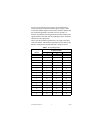
© National Instruments Corp. 7 FP-AI-112 and cFP-AI-112
(number of input ranges with 60 Hz filter) × 0.10 s +
(number of channels with 500 Hz filter) × 0.007 s +
(number of input ranges with 500 Hz filter) × 0.012 s + 0.16 s
= Update Period
For the fastest performance, configure all unused channels for the
500 Hz filter setting and for an input range in use on one or more
other channels with the 500 Hz filter setting. For example, if
10 channels are configured for 0–10 V input and 500 Hz, four
channels are configured for 0–5 V and 60 Hz, and two channels
are unconnected, use the FieldPoint software to configure the
unconnected channels for 0–10 V input and 500 Hz filter setting.
Some combinations of two input ranges count as only one range for
calculating update rates. Those combinations are ±60 mV and
±300 mV; 0–1 V and 0–5 V; and ±1 V and ±5V.
The update rate does not affect the rate at which the network
module reads the data. Set up your application so that the update
rate is faster than the rate at which the network module polls the
[c]FP-AI-112 for data.
Status Indicators
The [c]FP-AI-112 has two green status LEDs, POWER and
READY. After you insert the [c]FP-AI-112 into a terminal base or
backplane and apply power to the connected network module, the
green POWER indicator lights and the [c]FP-AI-112 informs the
network module of its presence. When the network module
recognizes the [c]FP-AI-112, it sends initial configuration
information to the [c]FP-AI-112. After the [c]FP-AI-112 receives
this initial information, the green READY indicator lights and the
module is in normal operating mode.
Upgrading the FieldPoint Firmware
You may need to upgrade the FieldPoint firmware when you add
new I/O modules to the FieldPoint system. For information on
determining which firmware you need and how to upgrade your
firmware, go to
ni.com/info and enter fpmatrix.


















